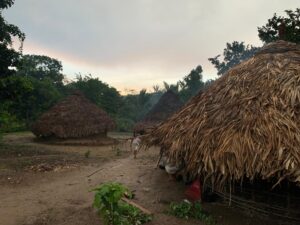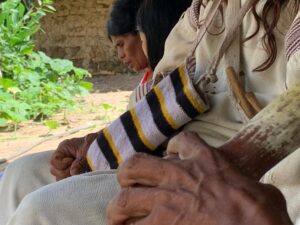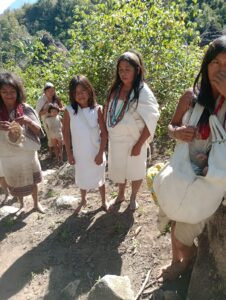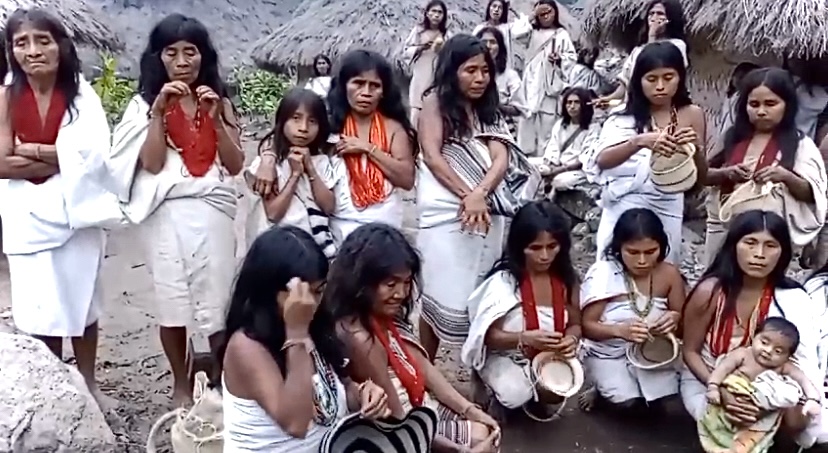
Our project focuses on the continued wisdom transmission of these Kogi holy women, ensuring that this knowledge is honored and shared in ways that are determined by the Kogi themselves as directed by the Mámas, the spiritual leaders of the communities.
The Kogi Sanhas, their Holy Women and Spiritual Midwives
introduction by Mary Olivar, Vice President
The Kogi Lineage

For many reasons, including their remote location, the diversity of ecosystems and microclimates in their area from sea level to snow peak, and how they have positioned themselves so close to nature while preserving their traditional knowledge, the Kogi people are seen as spiritual leaders for other Indigenous communities. Sometimes referred to as the “older brothers”, or older siblings, the Kogi are seen as guides to remembering the old spiritual knowledge that is deeply aligned to Mother Earth.
Midwifery Arts
The practice of midwifery for women and for the Kogi is an active ancestral practice that helps them maintain their original nations, culture, and identity. The primary focus of this project is on the Sanha midwives and what they carry both in their knowledge and in their practice and existence. Included in this knowledge of childbirth is also knowledge of the portal between life and death. There is also a commitment to strengthening the role of midwives in the community, as well as how they can include the youth and impart this spiritual knowledge to them.
The following is an article shared with us by our partners in Colombia on this project.
Gamá (mochila)
Woven bags of the Kogi, made from the a South American agave type plant.
By: Camilo Nuevita , Máma Jose Miguel Nuevita, and Adriana S. Vega
Sierra Nevada de Santa Marta, Colombia
The system of living ancestral knowledge, which holds the older brothers as intertwined with the original web-of-life codes, is to thank for the possibility that a gáma mochila bag could be carried by the younger brothers (as the Kogi call the civilized brothers and sisters). These woven bags, mochilas or gamá in the native Kággaba language represent a series of aesthetic, practical, and functional qualities that become vital in the daily life in La Sierra Nevada de Santa Marta, Colombia.
Male & Female Exchange
The coexistence of the Kággaba or Kogi with the animal and plant world of La Sierra brings a series of possibilities of integration: Máma José Miguel says that making gamá (mochilas) emerged as an original teaching that was about the exchange between the Kággaba man and woman, sharing that the mochilas also exists in the physical and spiritual dimension.
To work with agave-hemp plant and collect the natural colors, a spiritual payment is made to the father of the trees who is called “Kalakshe”.
The weaving process begins with the man’s work of ensuring the cultivation of the Mauritius-hemp plant (Furcraea cabuya), cutting it, breaking it down, shredding it, and then passing it on to his haba (woman) to continue with the washing, drying, and unraveling of the plant, then the long and intensive process of turning it into yarn. Once this is done, after many days, she will prepare the natural pigments made from tree bark, leaves and roots, which she mixes to impart these characteristic pigments to the Kogi bags. With these painted fique threads, she will begin the weaving process, and this fabric will accompany her wherever she goes for one moon cycle (a month). The fortitude and commitment of a haba (woman) is shown in her dedication to weave a mochila.
Made with Meaning

The meaning of gamá (mochilas) has always accompanied the growth process of boys and girls, becoming a symbolic element that will change from plain natural color to the respective colorful one, once it passes from child to adult. For a man, carrying the mochila will mean carrying his wife with him.
When a haba gives the gamá to a younger Kogi, it is equivalent to a moment of knowledge transmission that shares her experience on how the young woman can live from then on. The haba gives all her best advice on what should be respected, so that one does not live with a negative mind. She teaches how women and men support each other in joint spiritual work, especially for the specific case of being a máma or sanha (spiritual advanced kággaba authorities).
Sharing the Gáma Mochilas

On the other hand, it is believed that bringing the mochilas into the civilized world can raise awareness in valuing an ancient technology that contributes in a very beautiful way, to resolve the transition of dependence of the younger brother on bags made of plastic. Meanwhile, this possibility energized a healthy economy for Kogi families who do not have their own economic options and would allow them to access whatever little they have collectively agreed to use from the civilized world.
When the younger brother wears a gamá (mochila), this shows to the older brothers that he or she is already trustworthy; they think it looks good and that it represents a symbol of a relationship that unites them.
These amazing woven mochilas are coming soon to our Shop!!! The Center has been very fortunate to receive the gift of several Gamá mochilas made by the Kogi Sanhas, which will be available to purchase soon to further support them as they wish. The proceeds of the sale of these beautiful mochilas will go to fund the continuing preservation of Kogi wisdom among the Indigenous people of Columbia.
You can learn more about the Kogi Spiritual Midwifery Project here.


